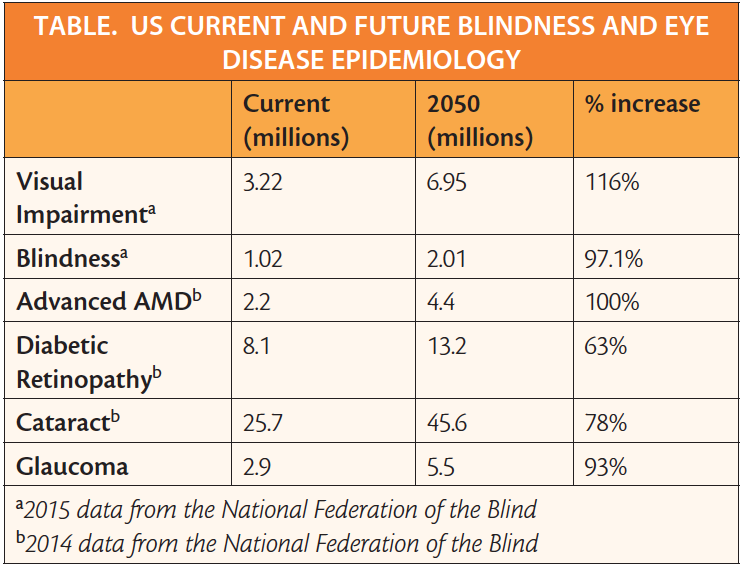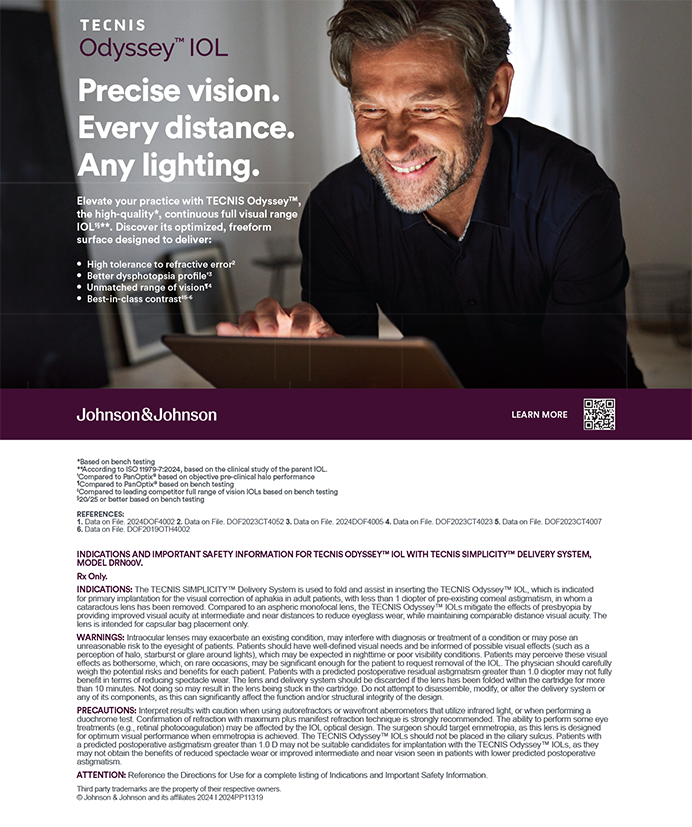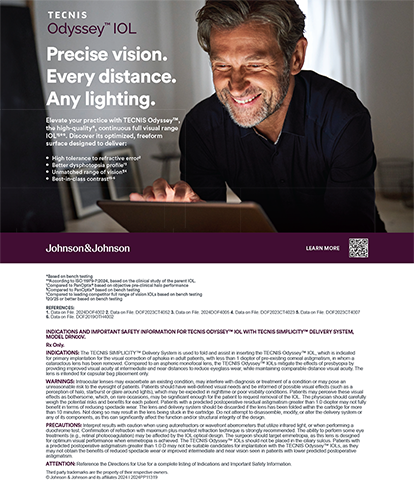
The eye care field is facing a near crisis situation with regard to its capacity to care for patients with age-related conditions. Projected increases in the prevalence of diseases that result in visual impairment (Table), set against a backdrop of better detection and improved access to care, suggest that potential human resource shortages could result in inconsistent, inadequate delivery of care. Fortunately, there is still time to adjust our care model, to find greater efficiencies and ensure minimal disruption in patient care with no compromises in the quality of that care.
The emergence of the medical model of optometry provides a unique opportunity to mimic trends in other parts of medicine, where non-MD providers deliver essential care. Up to 30% of primary care providers in internal medicine are either physician assistants or nurse practitioners; studies show that, when care is delivered by these kinds of providers, there is no tradeoff in quality.1 Similar findings have been noted with regard to nurse anesthetists assisting in anesthesiology.2

There are already examples in eye care in which optometrists play a collaborative role in the management of patients, including in cataract and refractive surgery. It is estimated that 20% of optometrists practice in a setting that also includes an ophthalmologist, and 50% of ophthalmologists employ an optometrist.3 Unlike in ophthalmology, which has a fixed number of residency openings and thus limited potential for growth, in optometry the number of practitioners is expected to grow from 40,000 today to 46,300 by 2022.4
THE MAYO MODEL
The collaborative care model of ophthalmology and optometry working together is predicated on finding solutions that maximize efficiency, while ensuring the highest degree of safety and quality of care, in order to deliver superior outcomes. The patient is always the focus. As the numbers mentioned above indicate, there is little question that optometry-ophthalmology partnerships can be successful when the two specialties work side by side in the same practice setting. A more pointed question is whether high quality care delivery can be achieved when ophthalmologists and optometrists work together in concert in the care of the same patients.
The Mayo Clinic of Rochester, under the leadership of Cheryl L. Khanna, MD, developed a collaborative care model in which optometrists who have received extra training in managing glaucoma patients work intimately in the care of these patients. In this highly structured program, two glaucoma specialists, one comprehensive ophthalmologist, and two optometrists share patient care responsibilities in a highly organized manner.
In this model, all new glaucoma/glaucoma suspect patients undergo baseline diagnostic testing and workup.5 If a definitive diagnosis of glaucoma is made, the patient is seen by one of the glaucoma specialists to set a target intraocular pressure (IOP) and create an individualized treatment plan. These patients are then followed by the optometrists and seen by the glaucoma specialist either every two years or earlier if progression occurs or surgery is indicated. If the patient is deemed a glaucoma suspect, he or she is referred for follow-up to one of the staff optometrists.
The outcomes with this simple model have been positive. Dr. Khanna and her team have streamlined their approach to get more patients access to specialized care, and she has opened new slots for surgery (personal communication). The Mayo team is publishing studies on its model soon, including a cost-effectiveness analysis and a presentation of their outcomes.
KELLOGG MODEL FOR GLAUCOMA CARE
At the Kellogg Eye Center, we have adopted a program that is similar to the Mayo model but less formally structured. I started working in the glaucoma clinic with the section chief, Sayoko Moroi, MD, PhD, in a collaborative care model about 2 years ago. Although I had been practicing optometry for about 12 years at the time, I underwent a 6-month mini-fellowship under Dr. Moroi’s tutelage to ensure that we were on the same page as far as objectives, responsibilities, and philosophies regarding patient care. As much as this was a valuable learning experience for me, it also helped that Dr. Moroi introduced me to her patients to establish familiarity with her very loyal patient population.
Our program has a simpler structure than the Mayo setup, mostly because only Dr. Moroi and I are working in the clinic. At first, we alternated patient visits, but now we arrange it so that she sees patients typically once a year, while I handle the rest of the visits unless her expertise is required.
As far as responsibilities, I routinely handle dilated examinations and gonioscopy, medication management, test interpretation, and patient education. I handle some postoperative care, including after selective laser trabeculoplasty, although Dr. Moroi typically performs the immediate follow-up with patients who have had invasive glaucoma surgeries such as tube shunt implantation and trabeculectomy.
Making our model work in practice requires attention to details. For example, we must be diligent about charting in order to facilitate good communication. Because we are rarely in the clinic at the same time, we schedule a face-to-face meeting at least once a month. We stay in touch by regularly communicating through phone and email. But these are minor efforts that allow us to achieve a large reward. With my collaboration on routine patient care, Dr. Moroi’s schedule has been freed up to do more research and to take on additional surgical cases.
GAUGING OUTCOMES
There are several ways to determine whether a collaborative care model of glaucoma is successful. Several studies have quantified that optometric involvement in glaucoma care resulted in good outcomes. For example, a retrospective study evaluated glaucoma patient outcomes and management with primary optometric care in 500 patients at the Centre for Eye Health in Sydney, Australia. The study authors found that “high quality and reproducibility of diagnosis and management recommendation protocols were confirmed.”6 A randomized, controlled study, the Bristol Shared Care Glaucoma Study, was conducted to determine whether community-based optometrists in the United Kingdom could make valid assessments of glaucoma patients. Those authors found that examination outcome measures were comparable in accuracy to those made at a hospital eye service.7
Patients generally have no complaints about seeing an optometrist rather than a glaucoma specialist; 81% of respondents to one survey in Australia said they found it easier to travel to their optometrist than visit the Royal Victorian Eye and Ear Hospital in Melbourne for specialist care.8 Patients in the Bristol study cited above reported high satisfaction with their wait times, travel times, and amount of time spent with their practitioner.6
There are also supporting data from other situations in which the use of non-MD providers is the norm. A survey of patients asking about experiences with physician assistants and nurse practitioners reported that approximately half said they would choose these two types of caregivers for their primary care needs. Results were more favorable as patients’ exposure to these caregivers increased. Notably, respondents to the survey reported shorter wait times, more accessibility, lower costs, high comfort levels, and more compassionate care with the non-MD caregivers.2
Decreasing wait times may have particularly important implications for outcomes in glaucoma patients. One study found a correlation between low waiting room times and adherence to prescription requirements.9 There are other potential advantages as well, including increase in patient volume, improved access to glaucoma specialty care for those who need it, decreased patient travel times, and greater cost-effectiveness.
CONCLUSIONS
To speak personally for a moment, collaborative glaucoma care has allowed me to serve patients using the full extent of my training. My previous experience with low vision rehabilitation, ocular disease, and contact lenses has proved to be valuable in numerous patient encounters. And I have found that having two practitioners with different approaches and mindsets working on the same problem often leads to beneficial results.
I enjoy the unique challenge of managing glaucoma, and I find it very rewarding to help patients maintain their vision and their quality of life. With regard to measuring outcomes, professional satisfaction is important, as it breeds greater engagement with patients. The collaborative model of glaucoma is one that can enhance the delivery of patient care and benefit the institution, the providers, the payers, and the patients.
1. Khatana A. Does the integrated MD-OD model represent the future? Glaucoma Today. 2014;12(3):32-33.
2. Dill MJ, Pankow S, Erikson C, Shipman S. Survey shows consumers open to a greater role for physician assistants and nurse practitioners. Health Aff (Millwood). 2013;32(6):1135-1142.
3. Fingeret M. The optometrist’s role in glaucoma care. Glaucoma Today. 2014;12(3):30-41.
4. The State of the Optometric Profession. Jobson Medical Information. 2013. https://www.aoa.org/Documents/news/state_of_optometry.pdf. Accessed August 10, 2016.
5. Moroi S, Newman-Casey NS, Wood S, Khanna C. The glaucoma specialist’s extended-care network. A patient-centered model for the future. Glaucoma Today. 2015;13(4):35-38.
6. Jamous KF, Kalloniatis M, Hennessy MP, et al. Clinical model assisting with the collaborative care of glaucoma patients and suspects. Clin Experiment Ophthalmol. 2015;43(4):308-319.
7. Gray SF, Spencer IC, Spry PG, et al. The Bristol Shared Care Glaucoma Study: validity of measurements and patient satisfaction. J Public Health Med. 1997;19(4):431-436.
8. O’Connor PM, Harper CA, Brunton CL, et al. Shared care for chronic eye diseases: perspectives of ophthalmologists, optometrists and patients. Med J Aust. 2012;196(10):646-650.
9. White AJ, Green CM. Collaborative care: the way of the future. Clin Experiment Ophthalmol. 2015;43(5):401-402.
Sarah Dougherty Wood, OD, MS, FAAO
• optometrist and clinical instructor, ophthalmology and visual sciences, Kellogg Eye Center, University of Michigan, Ann Arbor, Michigan
• (734) 615-2479; skwood@med.umich.edu


